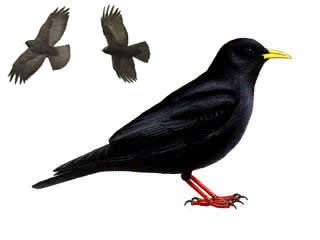Passeriformes Corvidae Alpine Chough (Pyrrhocorax graculus)
[order] Passeriformes | [family] Corvidae | [latin] Pyrrhocorax graculus | [UK] Alpine Chough | [FR] Chocard à bec jaune | [DE] Alpendohle | [ES] Chova piqigualda | [IT] Gracchio | [NL] Alpenkauw
Physical charateristics
Medium-sized, rather small-headed, graceful crow. Black, with relatively small, short, decurved yellow bill and red legs.
Sexes similar, no seasonal variation.
Sexes similar, no seasonal variation.
| wingspan min.: | 75 | cm | wingspan max.: | 85 | cm |
| size min.: | 37 | cm | size max.: | 39 | cm |
| incubation min.: | 18 | days | incubation max.: | 21 | days |
| fledging min.: | 29 | days | fledging max.: | 31 | days |
| broods: | 1 | eggs min.: | 3 | ||
| eggs max.: | 5 |
Distribution
Pyrrhocorax graculus has a fragmented distribution in the mountains of central and
southern Europe, which accounts for less than half of its global range. Its European
breeding population is large (>130,000 pairs), and was stable between 1970-1990.
This trend continued during 1990-2000, with the vast majority of European
populations-including key ones in France, Russia and Turkey-probably remaining
stable overall.
southern Europe, which accounts for less than half of its global range. Its European
breeding population is large (>130,000 pairs), and was stable between 1970-1990.
This trend continued during 1990-2000, with the vast majority of European
populations-including key ones in France, Russia and Turkey-probably remaining
stable overall.
Listen to the sound of Alpine Chough
Copyright remark: Most sounds derived from xeno-canto
Habitat
Strictly mountains, breeding in middle latitudes of west Palearctic in generally colder climates and at greater altitudes than any other bird species, in Switzerland up to 3000 m and in Morocco up to 4000 m. While demanding inaccessible nest-site in enabled by mastery of air to range over wide variety of foraging habitats, from snowline to treeline or lower, tending however, to avoid snow cover and to favour alpine meadows, newly mown grasslands, and boulder slopes.
Foraging habits
From spring to autumn favours insects, particularly grasshoppers, Tipulidae larvae and beetles. In autumn and winter, berries. Diet often includes refuse or scraps, particularly in winter.
Feeds in pairs or flocks on open ground, often frequenting favoured sites. In summer, usually above treeline on short grass, rocks, scree, and cliffs.
Feeds in pairs or flocks on open ground, often frequenting favoured sites. In summer, usually above treeline on short grass, rocks, scree, and cliffs.
copyright youtube
Breeding habits
Breeds from early May to mid Jun in Alps, mid May to Jul in Morocco, Jun-Jul in Lebanon.
Nest site is located at a ledge or crevice in cave, cliff, tunnel, shaft, or building. Access to the nest sometimes through small entrance hole, with the site sometimes more than 10 m from entrance and often in darkness. The nest is a bulky mass of sticks, roots, twigs, moss, and plant stems. Lined with neat, compact cup of grass, fine twigs, rootlets, hair, and some feathers. Clutch size is 3-5 eggs, incubation lasts 18-21 days, by female only. The young fledge in 29 to 31 days.
Nest site is located at a ledge or crevice in cave, cliff, tunnel, shaft, or building. Access to the nest sometimes through small entrance hole, with the site sometimes more than 10 m from entrance and often in darkness. The nest is a bulky mass of sticks, roots, twigs, moss, and plant stems. Lined with neat, compact cup of grass, fine twigs, rootlets, hair, and some feathers. Clutch size is 3-5 eggs, incubation lasts 18-21 days, by female only. The young fledge in 29 to 31 days.
Conservation
This species has a large range, with an estimated global Extent of Occurrence of 1,000,000-10,000,000 km². It has a large global population, including an estimated 260,000-620,000 individuals in Europe (BirdLife International in prep.). Global population trends have not been quantified, but the species is not believed to approach the thresholds for the population decline criterion of the IUCN Red List (i.e. declining more than 30% in ten years or three generations). For these reasons, the species is evaluated as Least Concern. (source Birdlife.org)

Migration
Mainly sedentary, except for altitudinal movements. Alpine populations often make diurnal altitudinal movements of up to several km between feeding and roosting sites. In Switzerland, daily movements may exceed 20 km in length and cover 1600 m altitude. More birds than formerly may remain high in Alps in winter due to development of skiing above 3000 m and consequent artificial food sources.
Distribution map breeding season

Distribution map wintering season

Literature
Title WINTER MOVEMENTS OF THE ALPINE CHOUGH: IMPLICATIONS FOR MANAGEMENT IN THE ALPS
Author(s): P. Laiolo, A. Rolando & L. Carisio
Abstract: The home ranges and movements of marked Alpine cho..[more]..
Source: J. Mt Ecol. 6:21-30
Title Geographic diversification in the call repertoire of
the genus Pyrrhocorax (Aves, Corvidae)
the genus Pyrrhocorax (Aves, Corvidae)
Author(s): Paola Laiolo, Antonio Rolando, Anne Delestrade, and Augusto De Sanctis
Abstract: We analysed the call repertoires of the Red-billed..[more]..
Source: Can. J. Zool. 79: 1568-1576 (2001)
Title Sexual Size Dimorphism and Positive Assortative Mating in Alpine Choughs (Pyrrhocorax graculus)
Author(s): ANNE DELESTRADE
Abstract: The degree of sexual size dimorphism in a number o..[more]..
Source: The Auk 118(2):553-556, 2001

